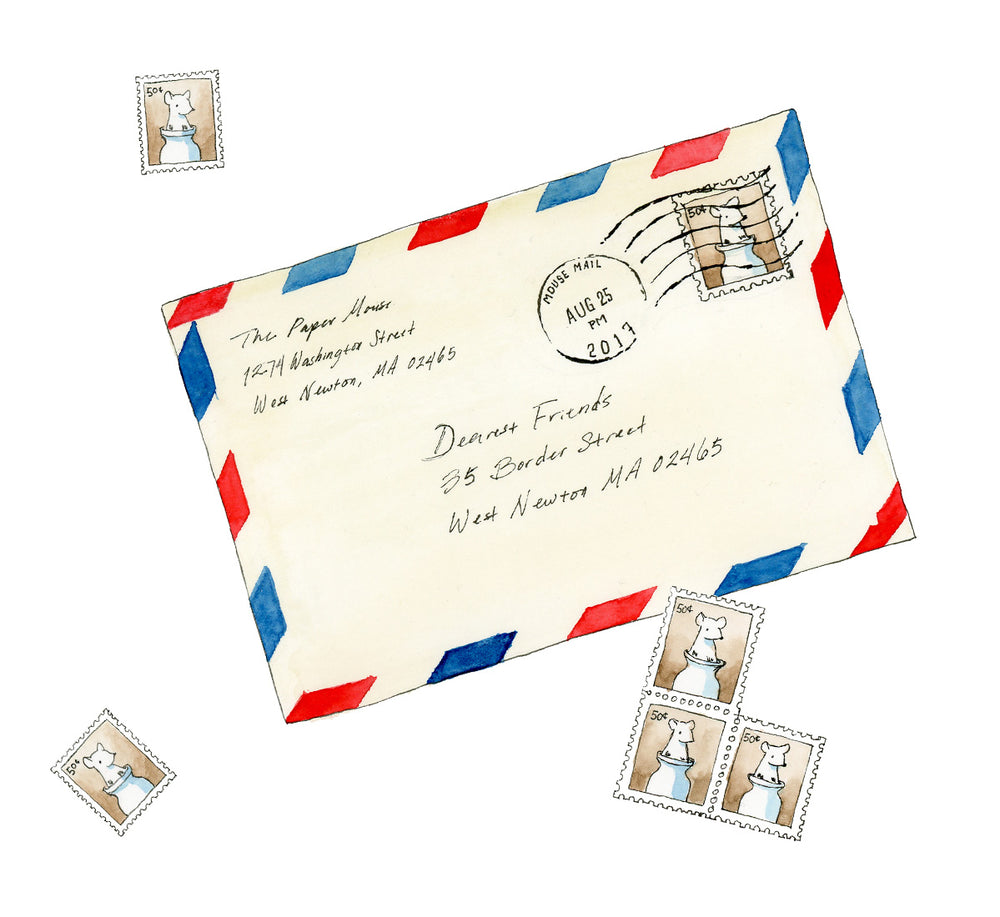How to Make a Pamphlet Book

Learn to sew a simple pamphlet book! This is an easy little booklet that can be adapted to endless variations by changing the size and color of the covers and pages. Once you’ve mastered the basic pamphlet stitch, you can get creative with the possibilities.
In this tutorial we’ll be making an A2 size (4.25” x 5.5”) pamphlet book, but you can make any size book you like. We’ll include tips for adapting the size of your book along the way.
For this tutorial, you’ll need:
- At least two pieces of paper for your book pages, 5.5” x 8.5” (you can cut a piece of 8.5” x 11” paper in half for this)
- A piece of cardstock or cover paper, 5.5” x 8.5”
- Scissors
- A ruler
- A pencil
- A needle and thread (see more about thread in step 8)
- A cutting mat or piece of cardboard to protect your work surface
- If you have them: a paper cutter or utility knife, a bone folder, a skinny awl, and beeswax for waxing your thread
1. Start by cutting your book’s cover and pages. For this tutorial, we cut ours to 8.5” x 5.5”, or half the size of a piece of standard printer paper. A paper cutter will make this easy, but you can also use a ruler and a pair of scissors or a utility knife.
You can get creative with the papers you use for your cover and pages. A thicker paper like cardstock works well for the cover, while thinner pages work well for the interior. Cut at least two pieces of paper for the inside pages (they'll be folded in half to create double the number of pages), but you can use more if you like—just remember that the more pages you add, the thicker your book will be. We used four sheets in our example.
If you’re making a different size book: Cut your pages to the height of your finished book and make them twice as wide as you want the finished book to be.

2. Fold the cover and pages in half one at a time, creasing each page firmly in the middle. If you have a bone folder you can use this to crease the pages, but if not, a fingernail or the back of a spoon also work well.
It can be tempting to fold the pages all together at once, but you’ll get a neater crease and tighter pages if you fold them one by one.

3. Take all the interior pages of your book and lay them one inside another so they are all nested together in one booklet. In bookbinding, a group of nested pages like this is called a signature. Pamphlet books have only one signature.

4. Now we’ll measure out the sewing holes. Open your signature to the middle and lay a ruler across the center of it, along the folded “gutter.” Measure the distance to the center of the gutter and make a dot. Our book is 5.5 inches across, so we’ll make our center dot at 2.75 inches.
Next, we’ll measure out dots at one-inch intervals on either side of the center dot. Make five dots in total, at 0.75 inches, 1.75 inches, 2.75 inches, 3.75 inches, and 4.75 inches. You should end up with five evenly spaced dots, each an inch apart from the next one.
If you’re making a different size book: Pamphlet books are always made with an odd number of holes. You will need at least three holes, but you can add more if you like and can choose to space them closer together or farther apart. Start by making one dot in the center, and measure out your other holes from the center dot.

5. Repeat this process with the cover, making the same number of dots at the same intervals as you did on the pages.

6. To poke the holes, we’ll use a long, skinny awl. If you don’t have an awl available, a thick sewing needle will work as well.
Hold your signature firmly together so the pages stay lined up. (You can also clip the signature together on both ends with paper clips to keep the pages from shifting around.) Starting with the center dot you made, carefully poke your awl or needle from the inside of the pages through to the outside.
To get a neat hole, open up your signature and gently press the tip of the needle into your pencil mark, then fold the pages closed while you poke through the folded spine.
Repeat this process on the cover. Poking the cover and signature holes separately will give you the neatest results.


7. Nest your pages inside your cover.
Measure out your thread. If you’re following along with our measurements, cut at least 14 inches of thread.
If you’re making a different size book: Measure the distance between the two farthest holes you poked. Multiply that number by 2 and add at least 6 inches for a tail. In our example, the holes are spread across 4 inches, so we multiplied 4 by 2 to get 8 inches of thread, and added 6 inches for a minimum of 14 inches of thread.

9. If you have a bit of beeswax available, run your thread through the beeswax two or three times so it’s evenly coated, making sure there aren’t lumps of wax left on the thread. You can use sewing beeswax or drippings from a beeswax candle. If you don’t have wax available, we’ll make do without!

10. Thread a sewing needle with your length of thread. Don’t double your thread over or tie a knot in the end.

11. To sew your pamphlet book, you can start either from the inside or the outside of the book. If you start from the inside, you’ll end up with two small tails of thread on the inside, and vice versa. In our example, we’re starting from the inside of the book.
Starting at the center hole, poke your needle through all the pages and the cover. Pull the thread through, leaving a tail of a couple inches. Don’t tie a knot in this tail. Instead, you’ll hold it in place with your nondominant hand as you sew, or you can tape it down temporarily with a piece of washi tape or other gentle removable tape.


12. Now your thread should be coming out of the center hole on the outside of the spine (or the inside, if you started sewing from the outside). Poke your needle through the hole to the right of the center hole and pull the thread through.


13. Continuing to sew toward the righthand edge, poke your needle through the next hole and pull the thread through. Tug it gently to pull it taut.
If you’re making a different size book: If you added more than five holes to your book, continue to follow this pattern, sewing in one direction until you reach the last hole.


14. Now you’ll switch directions. Poke your needle back through the previous hole (it will already have a stitch through it). Pull the thread through and tug it gently to pull it taut.


15. As you sew in the opposite direction, skip over the center hole and move straight to the hole to the left of the center. You’ll end up with one longer stitch down the middle of your book.


16. Continue sewing to the left, poking your needle through the next hole and pulling the thread through. Tug it gently to pull it taut.


17. When you reach the last hole on the left, switch directions. Poke your needle back through the previous hole (it will already have a stitch through it). Pull the thread through and tug it gently to pull it taut.


18. Finally, poke your needle back through the center hole. Before you pull the needle all the way through, open up the book and look at where the needle is poking through. The tail of thread you started with will be coming out from underneath the long middle stitch, either to the left or right of the stitch. Wiggle your needle so it’s poking out in the opposite direction. You’ll end up with two tails of thread, one on either side of the long center stitch.


19. Remove the needle. Gently pull both tails of thread to make the stitches tight (being careful not to pull too hard so you don’t tear the pages). Tie the two tails together in a knot on top of the center stitch.
If you waxed your thread with beeswax, you only need to tie the threads once—the wax will help the knot stick. If you didn’t have beeswax available, tie the threads twice so the knot will stay tight.

20. Trim the tails of thread. Don’t cut too close to the knot—leave at least an inch on either side. If your tails are on the outside of the book, you can make them a decorative element by tying them in a bow or adding beads to the thread.

21. Your book is all sewn up! There will be 4 stitches along the side (or more if you added extra holes).
You may notice that your pages are sticking out slightly past the cover: the thickness of the paper makes them stick out. If this is the case, you can trim your book to make it straight again.

22. To trim the edge of your book, lay a ruler down across the edge with the excess paper sticking out past the ruler. Press down on the ruler very firmly with one hand, making sure that it doesn’t shift around. With the other hand, gently run a utility knife down the edge of the ruler. Run the knife along the ruler over and over again until the excess paper is cut away.
It’s more important to put pressure on your ruler hand to keep the ruler straight than to press hard on the knife. Just keep repeating this motion with the knife until the paper comes loose.
Tip: A utility knife with a straight fixed blade works better for this purpose than an X-ACTO knife, which tends to curve and wiggle while you cut.

Voila—you’re done! Now you can make booklets of all different shapes and sizes to use as pocket journals, creative greeting cards, and gifts.




Thank you so much for this tutorial! I enjoyed making one of these little notebooks and am definitely going to make more!
Thank you so much for this Tutorial It was easy to understand The instructions were very clear along with the video also Thank you again Wishing you and your family a Wonderful Holiday Season I can’t wait to visit your store in the New Year
Leave a comment